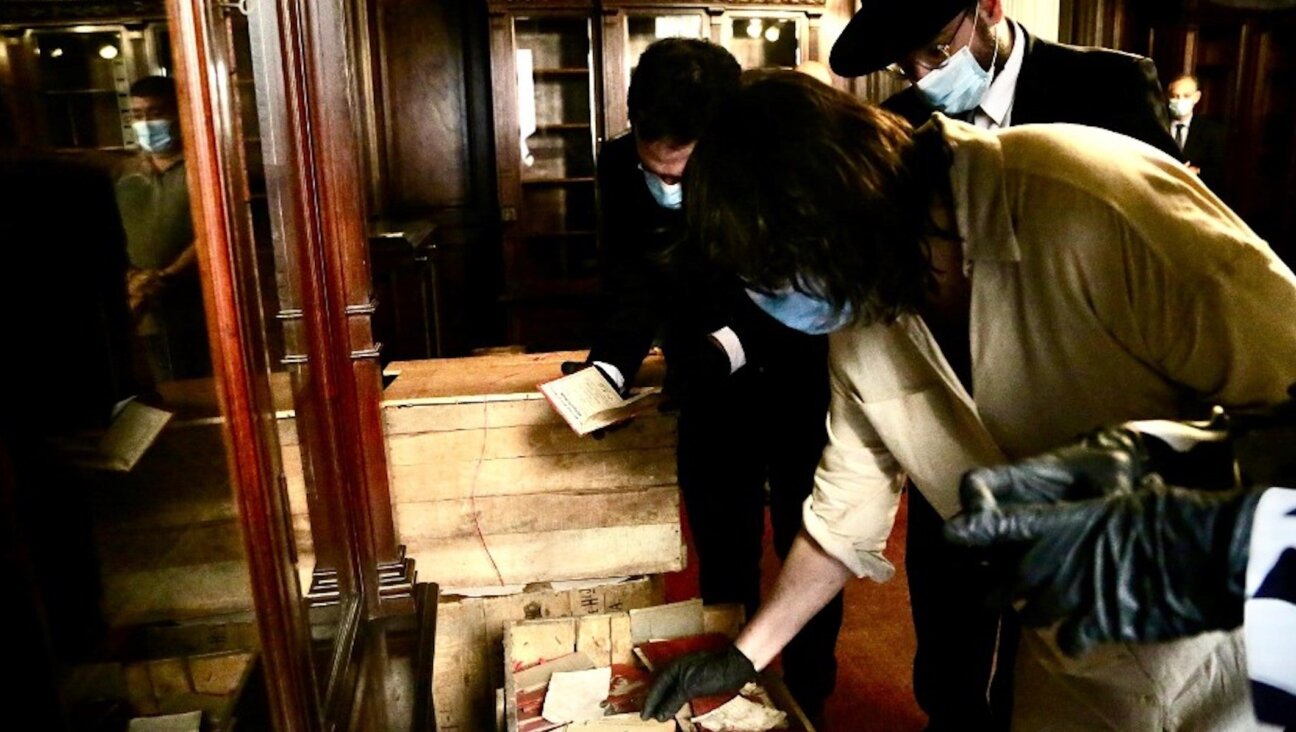Il Duce’s Own Idea
The Jews In Mussolini’s Italy from Equality to Persecution
By Michele Sarfatti
The University of Wisconsin Press, 419 pages, $57.30.
In 1934, Benito Mussolini famously declared that “there has never been antisemitism in Italy.” A mere four years later, after abandoning his Jewish mistress of 27 years, he passed his infamous racial laws.
Michele Sarfatti’s “The Jews in Mussolini’s Italy” explains this startling reversal, providing new interpretations of an often misunderstood aspect of Holocaust history. The most comprehensive work to date, this expanded English edition is destined to become the definitive text on the subject. Sarfatti, director of the Centro di Documentazione Ebraica Contemporanea in Milan, chronicles the history of Italian Jews from Mussolini’s rise to power in 1922 to his downfall in 1945.
Based on newly discovered documents and an abundance of statistical data, the book demonstrates that, contrary to popular belief, Mussolini’s policies toward the Jews were independently conceived and implemented, and not — as some have argued — a late concession to Hitler’s war against the Jews. Despite Il Duce’s alliance with Hitler, “only” about 7,000 Italian Jews (16.3% of the Jewish population) died in Nazi death camps. Moreover, documented instances of Italians risking their lives to save Jews abound—a fact that reinforced the perception of Italians as “brava gente” (“good people,” the kind who helped preserve Jewish lives).
The book draws a three-dimensional picture of Jewish life in Fascist Italy in all its variety and nuanced complexity. There were Jews who at first adhered enthusiastically to Mussolini’s program, others were among the first to organize antifascist activities, as well as many who hoped to remain neutral. The range of activities of Italian Jews extended from academics and professionals all the way to shop keepers and panhandlers. What emerges is a heterogeneous population that professed varying degrees of religious identity and many different levels of assimilation.
Jews were so well integrated into Italian society that by 1922 when Mussolini took power, they were in every branch of government, including the military, and were represented all across the political spectrum. But antisemitic sentiment in Italy, as Sarfatti shows, can be traced far back. As he argues, the leftovers of the medieval Catholic anti-Judaism provided fertile grounds for anti-Jewish nationalism, which in turn fed Fascist antisemitism. The rise of an antisemitic ideology escalated with Italy’s colonial war in Abyssinia of 1935. The Fascists first developed the concept of “Difesa della razza” (“defense of the race”) in dominating the black population of the African colony. At this early stage, this doctrine had parallels only in Nazi Germany and was completely absent in the rhetoric of Fascist movements, from Spain to Hungry, Romania and Poland.
Among the author’s many original claims, he maintains that the seeds of antisemitism were present in the Fascist regime since its inception, though antisemitism was not yet official policy. With a multitude of documented examples, the book follows the antisemitic crescendo in both official political discourse and practice. As early as 1934, the office of the Interior Ministry pressed for the replacement of Ferrara’s mayor: “It has been brought to our attention that the local citizenry feels displeasure to have a mayor of the Israelite religion at the head of the city’s administration. Therefore, it is desirable that he be replaced with a Catholic mayor.” In 1938, the Italian dictator passed and enforced the racial laws, in many respects even more restrictive than anti-Jewish legislation in Nazi Germany, and Italy became an officially antisemitic country. Sarfatti stresses that Mussolini was never pressured by Hitler regarding racial policies. Italians on the whole did not protest the laws until their lethal consequences became clear. By 1943, the Fascists began confiscating Jewish property and rounding up Jews for deportation, and abruptly many of those who had not protested against anti-Jewish laws rushed to save Jews.
Sarfatti’s meticulous reconstruction of the events of late 1943, when both the Nazi and the Fascist were arresting Italian Jews, clarifies the joint efforts of the two regimes. Although his collection of data sometimes interrupts his narrative, the book is a compelling read and a major contribution to a more sophisticated understanding of antisemitism in Fascist Italy.
Alessandro Cassin is a cultural critic and feature writer for L’Espresso, as well as a regular contributor to Il Diario, Tempo Presente and Lacanian Ink.
The Forward is free to read, but it isn’t free to produce

I hope you appreciated this article. Before you go, I’d like to ask you to please support the Forward.
Now more than ever, American Jews need independent news they can trust, with reporting driven by truth, not ideology. We serve you, not any ideological agenda.
At a time when other newsrooms are closing or cutting back, the Forward has removed its paywall and invested additional resources to report on the ground from Israel and around the U.S. on the impact of the war, rising antisemitism and polarized discourse.
This is a great time to support independent Jewish journalism you rely on. Make a gift today!
— Rachel Fishman Feddersen, Publisher and CEO
Support our mission to tell the Jewish story fully and fairly.
Most Popular
- 1

Fast Forward Ye debuts ‘Heil Hitler’ music video that includes a sample of a Hitler speech
- 2

Opinion It looks like Israel totally underestimated Trump
- 3

Culture Is Pope Leo Jewish? Ask his distant cousins — like me
- 4

Fast Forward Student suspended for ‘F— the Jews’ video defends himself on antisemitic podcast
In Case You Missed It
-

Fast Forward For the first time since Henry VIII created the role, a Jew will helm Hebrew studies at Cambridge
-

Fast Forward Argentine Supreme Court discovers over 80 boxes of forgotten Nazi documents
-

News In Edan Alexander’s hometown in New Jersey, months of fear and anguish give way to joy and relief
-

Fast Forward What’s next for suspended student who posted ‘F— the Jews’ video? An alt-right media tour
-
Shop the Forward Store
100% of profits support our journalism
Republish This Story
Please read before republishing
We’re happy to make this story available to republish for free, unless it originated with JTA, Haaretz or another publication (as indicated on the article) and as long as you follow our guidelines.
You must comply with the following:
- Credit the Forward
- Retain our pixel
- Preserve our canonical link in Google search
- Add a noindex tag in Google search
See our full guidelines for more information, and this guide for detail about canonical URLs.
To republish, copy the HTML by clicking on the yellow button to the right; it includes our tracking pixel, all paragraph styles and hyperlinks, the author byline and credit to the Forward. It does not include images; to avoid copyright violations, you must add them manually, following our guidelines. Please email us at [email protected], subject line “republish,” with any questions or to let us know what stories you’re picking up.














